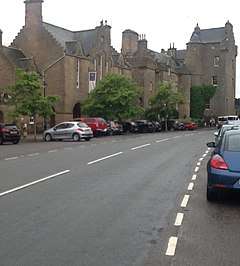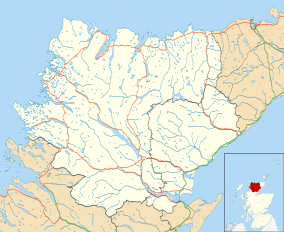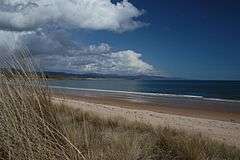Dornoch
Dornoch (/ˈdɔːrnɒx/; Scottish Gaelic: Dòrnach [ˈt̪ɔːrˠn̪ˠəx]; Scots: Dornach) is a town, seaside resort, and former royal burgh in the county of Sutherland in the Highlands of Scotland. It lies on the north shore of the Dornoch Firth, near to where it opens into the Moray Firth to the east.
| Dornoch | |
|---|---|
 Town centre | |
 Dornoch Location within the Sutherland area | |
| Population | 2,570 (2011)[3] |
| OS grid reference | NH798896 |
| • Edinburgh | 195 miles (314 km) |
| • London | 600 miles (970 km) |
| Council area | |
| Lieutenancy area | |
| Country | Scotland |
| Sovereign state | United Kingdom |
| Post town | DORNOCH |
| Postcode district | IV25 |
| Dialling code | 01862 |
| Police | Scotland |
| Fire | Scottish |
| Ambulance | Scottish |
| UK Parliament | |
| Scottish Parliament |
|

The town is within the Highland local government council area. The town is near the A9 road, to which it is linked by the A949 and the B9168. The town also has a grass air strip suitable for small aircraft and helicopters.
History
The name 'Dornoch' is derived from the Gaelic for 'pebbly place', suggesting that the area contained pebbles the size of a fist (dorn) which could therefore be used as weapons.[4] Dornoch has the thirteenth-century Dornoch Cathedral, the Old Town Jail, and the previous Bishop's Palace which is now the well-known hotel, Dornoch Castle and a notable golf course, the Royal Dornoch Golf Club, named the 5th best golf course outside the United States in 2005 by Golf Digest.
It is also notable as the last place a witch was burnt in Scotland. Her name was reported as Janet Horne; she was tried and condemned to death in 1727. There is a stone, the Witch's Stone, commemorating her death, inscribed with the year 1722.[5] The golf course designer Donald Ross began his career as a greenkeeper on the Royal Dornoch links. The golf course is next to the award-winning blue flag beach.
Dornoch used to be connected to the main railway network at The Mound via a light railway. The railway was opened on 2 June 1902. Stations on the line were Dornoch, Embo, Skelbo, Cambusavie Halt and The Mound Junction. The stations were shut on 13 June 1960.
Dornoch Academy Modern Languages teacher Margaret C. Davidson, led the National Union of Women's Suffrage Societies in the burgh from 1913, volunteered as a nurse in the Scottish Women's Hospitals in France in World War One, and returned to teach and serve as a Girl Guide leader in 1931.[6]
On 21 December 2000, the pop star Madonna had her son Rocco christened in Dornoch Cathedral, the day before her wedding to Guy Ritchie in nearby Skibo Castle.
On 13 January 2005, Dornoch was granted Fairtrade Town status.[7]
The Burghfield House Campus of the University of the Highlands and Islands in Dornoch is the home for the Centre for History[8] teaching undergraduate and postgraduate history degrees to students around the UHI network and worldwide.
Governance
Dornoch was a parliamentary burgh, combined with Dingwall, Kirkwall, Tain and Wick in the Northern Burghs constituency of the House of Commons of the Parliament of Great Britain from 1708 to 1801 and of the Parliament of the United Kingdom from 1801 to 1918. Cromarty was added to the list in 1832.
The constituency was a district of burghs known also as Tain Burghs until 1832, and then as Wick Burghs. It was represented by one Member of Parliament. In 1918 the constituency was abolished and the Dornoch component was merged into the then new county constituency of Caithness and Sutherland.
At the 6 May 2010, UK Parliamentary Election Dornoch was part of and continues to be part of the Caithness, Sutherland and Easter Ross Constituency. In the Scottish Parliament from 2011 Dornoch is part of Caithness, Sutherland and Ross a constituency of the Scottish Parliament. It elects one Member of the Scottish Parliament (MSP) by the first past the post method of election. It is also one of eight constituencies in the Highlands and Islands Scottish Parliament region, which elects seven additional members, in addition to eight constituency MSPs, to produce a form of proportional representation for the region as a whole.
There is also elected local government councillors, and as of November 2011 there are elected community councillors.
Dornoch in popular culture
Rosamunde Pilcher's last novel Winter Solstice is largely set in and around Dornoch, fictionalised under the name of Creagan.[9][10]
References
- "Ainmean-Àite na h-Alba (AÀA) – Gaelic Place-names of Scotland". www.ainmean-aite.scot. Retrieved 17 February 2019.
- "Scotslanguage.com - Names in Scots - Places in Scotland". www.scotslanguage.com. Retrieved 17 February 2019.
- "POPULATION CHANGE IN CAITHNESS AND SUTHERLAND 2001 TO 2011". Highland Council. 11 February 2014. Retrieved 11 February 2011.
- Field, John (1984). Discovering Place Names. Shire Publications. ISBN 978-0852637029.
- "The Witch's Stone, Dornoch, Am Baile, EN4946". www.ambaile.org.uk. Retrieved 17 February 2019.
- "Teacher | Mapping Memorials to Women in Scotland". womenofscotland.org.uk. Retrieved 29 April 2020.
- "Fairtrade Towns by Date". Fairtrade Foundation. 5 November 2010. Archived from the original on 13 January 2012. Retrieved 21 April 2012.
- "Centre for History - University of the Highlands and Islands". www.uhi.ac.uk. Retrieved 17 February 2019.
- "A Tour for Devotees of the Rosamunde Pilcher Novel visiting Kingsferry and Corrydale in the footsteps of Oscar and Elfrida". Inverness Tours. 2012. Retrieved 21 April 2012.
- "Harry Potter, Rosamunde Pilcher, Diana Gabaldon ..." Macnab.de. 2012. Archived from the original on 10 April 2012. Retrieved 21 April 2012.
| Wikimedia Commons has media related to Dornoch. |
.jpg)